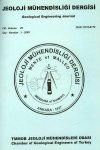
ABSTRACT: The Upper Cretaceous Baskil and Bilaser Tepe Magmatites and Pliocene sediments crop out throughout the study area within the Eastern Taurus Orogenic belt. On the basis of petrogrophical and geochemical studies, it has been concluded that the Baskil Magmatites belong to the volcanic-arc granitoids whereas the Bilaser Tepe Magmatites belong to the post-collisional granitoids. Two types of mineralization have been recognized, to be associated with the Bilaser Tepe Magmatites. First type is a porphyry-type copper mineralization vvhich has developed in granitoid, granite porphyry, and dacite porphyry phases of the Bilaser Tepe Magmatites and in diorites of the Baskil Magmatites making contacts with them. Second type is characterized by Au-and Cu-bearing auartz veints hosted in granites of the Bilaser Tepe Magmatites. First type of mieralization is accompanied by potassic, phyllic, auartz-sericite-carbonate and propylitic alteretion assemblages. Mineralization mainly occurs in quartz-carbonate veins or as coatings along fissures and cracks and as disseminations inplaces wherephyllite and qartz-sericite-carbonate alterataions prevail. Main ore minerals are pyrite, arsenopyrite, chalcopyrite and bismuthinite. Quartz veins belonging to the second type containpyrite, chalcopyrite with lesser amount of gold. These veins are envelopedby argillic and silide alteretions.
ABSTRACT: in recent years, high quality fresh water source becomes insufficient. Thus, sources of drinking and using water is became international commercial trade value. Manyfresh and mineral water springs are located in the Değirmendere basin. Değirmendere alluviums that were provided drinking water of Trabzon before the Esiroğlu cleaning and refining facilities become providing water, alsofound in the basin. The goal of current study is determination of auality, and quantity of fresh and mineral water , lources, and development basic knowledge about appropriate sourcesfor later investment. Surface, groundwaters and mineral yvaters of the Değirmendere basin have been investigated and hydrochemical properties have been determined. They were evaluated according to Turkish Standartsfor water and the Polluted Water Control Statement. According to hydrochemical properties ofstreams, spring and mineral waters in the Değirmendere basin, the dominant ions in waters are Ca+2 and HC03_, and all waters are classifıed as "calcium bicarbonate water". Mineral saturation index of the waters are calculated, and they are generally classifıed as unsaturated waters. Hoywever, mineral spring waters are saturated with calcite and dolomite. Groundyvaters are not saturated except a few well water saturated with calcite and aragonite. Representative water samples of the basin were analyzedfor some inorganic elements. Obtained data indicated that Sb and Se contents of the Yanlıca mineral water, and Cr and Pb contents the Akoluk mineral water are above the limits representing the Değirmendere equifer and the Kendirli aquifer`s water is also above the limits. According to pH, TDS, CT and S04-2 value, surface waters are high auality. But according to N02 value Sümela stream water is high auality, Meryemana, Maçka and Galyan streams waters are contaminated water, Değirmendere water is higly contaminated water quality. According to pH, TDS, Cl, SO42, NO 2 and N02 values groundwater of the Değirmendere basins are classifıed as high auality water.
ABSTRACT: The mineral waters, Budak, Tekkeköy, Akgedik, Yıldız, Yeşildere, İnkılap, Güvercinlikhave 0.023-1.5 liter/sec yields, 6.12-6.57pH, 9.2-16.7 Ctemperature, clear and sourish taste in Gümüşhane City vicinity. Güvercinlik and Yeşildere mineral springs are used by people living there. These mineral waters are investigated drinking vvater quality. Mn+2, Fe+2, Pb+2, Zn+2, Cu+2, Cd+2, As (total) and gross alpha and gross beta contents are studied and investigated suitability drinking. According to trace element contents Mn+2, Fe+2, Pb+2 in Budak and Akgedik mineral waters, Fe+2 Pb+2 in Yıldız, inkılap and Güvercinlik mineral waters, Pb+2 in Tekkeköy and Yeşildere mineral waters, exceed values in the WHO and TS 9130 standards. in the Yeşildere and Güvercinlik mineral waters Cd+2 content is maximum value in the standarts. in the other mineral waters it is higher than this value. According to radioactivity contents, alpha activities of mineral spring waters are behveen 0.12-0.308 Bq/l, beta activities are between 0.132-0.401 Bq/l. Alpha activities are higher than the optimal degree in all the investigated samples according to WHO and TS 9130. And these values show that, those spring waters are not suitablefor drinking.
ABSTRACT: This study has been c onducted around KBİ, Tügsaş and IPF that are located in Tekkeköy, Samsun, in order to reveal the impacts of these industries, Cu, Zn, Pb, Fe, Mn, Cd and S analyses in soil, plant and water samples were conducted. in the study area, Cu, Zn, Pb, Fe and Mn pollution was determined in soil samples and attributed to the above mentioned industrial facilities. Mostprobably the sources of Cu pollution are derived from KBİ, Tügsaş and IPF; Zn and Pb pollution originates from Tügsaş and IPF; Fe ve Mn pollution is attributed to KBI. in addition to this, taking in to account the samples collected from the surface (0-20 cm), and from depth (20-50 cm) around KBİ, the pollution appears to be limited to the soil surface. in the plant samples collected from the study area, KBİ and TÜGSAŞ appear to cause Cu, Pb, Zn and Fe pollution, and IPF appear to cause Cu and Pb pollution. Pollutants observed in tobacco (Nicotiana tobacum) are Cu, Pb, Zn, Fe and S; in maize (Zea mays) are Cu, Zn andFe; and in cabbage (Brassica oleracea) are Cu, Pb, Fe and S. in the watersamples collectedfrom the study area revealed that KBİ has causing Pb pollution and a relatively lower level of Cu and Fe pollution; TÜGSAŞ is causing a lower level of Cu, Fe and Mn; and IPF are causing Pb pollution anda relatively lower level of Fe and Mn pollution.

 TMMOB
TMMOB